---
title: 4th GouTP @ SCEE
subtitle: Python introduction for MATLAB users
author: Lilian Besson
institute: SCEE Team, IETR, CentraleSupélec, Rennes
date: Thursday 18th of January, 2018
lang: english
---
# 4th 2017/18 GouTP @ SCEE
- *About:* **Python introduction for MATLAB users**
- *Date:* 18th of January 2018
- *Who:* Lilian Besson
---
# What's a *"GouTP"* ?
- **Internal monthly technical training session** :date:
- Usually: *Thursday 3pm :clock3: - 3:30pm* :clock330:
- With :coffee: coffee and :cookie: sweets : we relax while training !
> Initiative of Quentin and Vincent :clap: in last January...
> Continued by Rémi and Lilian :ok_hand: !
## Not only @ SCEE ?
- Currently open to the *FAST* and *AUT* teams
---
# Agenda for today [30 min]
1. What is Python [5 min]
2. Main differences in syntax and concepts [5 min]
3. Examples of problems solved Python [10 min]
4. Where can you find more information ? [5 min]
---
# 1. What is Python :snake: ?
- developed and popular from the last 25 years
- Open-source and free programming language
- Interpreted, multi-platform, imperative and object-oriented
- Designed and acknowledged as *simple to learn and use*
- Used worldwide: research, data science, web applications etc
### Ressources
- **Website**: python.org for the language & pypi.org for packages
- Documentation : docs.python.org (:fr: [docs.python.org/fr/3](https://docs.python.org/fr/3) translation in progress)
---
# Comparison with MATLAB
| | Python :smiley: | MATLAB :cry:
|:-|:-:|:-:|
| **Cost** | Free :v: | Hundreds of euros / year
| **License** | Open-source | 1 year user license (no longer after your PhD!)
| **Comes from** | A non-profit foundation, and the community | MathWorks company
| **Scope** | Generic | Numeric only
| **Platform** | Any :computer: :iphone: | Desktop only :computer:
| **Usage** | Generic, worldwide :earth_americas: | Research in academia and industry
---
> But Python don't have only advantages…
| | Python :cry: | MATLAB :smiley:
|:-|:-:|:-:|
| **Packaging** | Different solutions (`conda`, `pip`, it works fine) | Toolboxes already included
| **IDE** | Many possibilities, have to chose one (*Spyder*) | Good IDE already included
| **Support?** | Community (StackOverflow, IRC, mailing lists etc) | By MathWorks ?
| **Performances** | Interpreted, not so fast (check *Pypy* for speed)| Faster (but worse than C, Julia)
| **Documentation** | OK but very diverse | OK and inline
---
# How to install Python :arrow_down:
- On Linux and Mac OS : already installed!
- On Windows:
+ You can use the default installer from [python.org/downloads/windows](https://www.python.org/downloads/windows/) :snake:
+ Or the full installer from [anaconda.com/download](https://www.anaconda.com/download/) (:sparkles:)
- Takes about 10 minutes... and it's free !
> :warning: Choose **Python 3** (currently 3.6.4) **not 2 !**
> :warning: Python 2 will stop :clock3: in less than 3 years (pythonclock.org)
---
# My suggestions for Python :snake:
- Use **Anaconda** to install (and upgrade) Python and packages
- Use **IPython** for the command line (:sparkles: awesome features !)
- Use:
+ **Spyder** for your IDE if you like the MATLAB interface
(installed in Anaconda, or github.com/spyder-ide/spyder)
+ **PyCharm** if you want "the most powerful Python IDE ever"
+ Or a good generic text editor + a plugin for Python
(Emacs, Vim, Atom, SublimeText, **Visual Studio Code**…)
- Use **Jupyter notebooks** to write or share your experiments
(jupyter.org, eg. github.com/Naereen/notebooks)
> More suggestions: pierreh.eu/python-setup by Pierre Haessig
---
## :package: How to install modules in Python
- If you used Anaconda, use `conda install [name]` (in a terminal) to install module `[name]`,
- Or with the standard installer, use `pip install [name]`.
## :mag: How to find the module you need ?
- Ask your colleagues :smile: !
- Look on the Internet !
- Look directly on [pypi.org](https://pypi.org) (official) or [anaconda.org](https://anaconda.org)
---
# :package: Overview of main Python modules
> Standard library is very rich, but not for scientific applications
- **Numpy** (numpy.org) for `numpy.array` for multi-dim arrays and linear algebra
- **Scipy** (scipy.org) for numerical computations (signal processing, integration, ODE integration, optimization etc)
- **Matplotlib** (matplotlib.org) for MATLAB-like 2D and 3D plots
- **pandas** for data manipulation (very powerful)
- **Scikit-Learn** (scikit-learn.org) for "classical" Machine Learning
- **Scikit-image** for 2D and generic image processing
- **Keras** (keras.io) for neural networks and deep learning
> And many others ! Check pypi.org
---
# 2. Main differences in syntax between Python and MATLAB
> Ref: mathesaurus.sourceforge.net/matlab-python-xref.pdf
| | Python | MATLAB
|:-|:-:|:-:|
| **File ext.** | `.py` | `.m`
| **Comment** | `# blabla...` | `% blabla...`
| **Indexing** | `a[0]` to `a[-1]` | `a(1)` to `a(end)`
| **Slicing** | `a[0:100]` (view) | `a(1:100)` (:warning: copy)
| **Operations** | Element-wise by default | Linear algebra by default
| **Logic** | Use `:` and indexing | Use `endif` `endfor` etc
---
| | Python | MATLAB
|:-|:-:|:-:|
| **Help** | `help(func)` or `func?` (IPython) | `help func`
| **And** | `a and b` | `a && b`
| **Or** | `a or b` | `a || b`
| **Datatype** | `np.array` of *any* type | multi-dim doubles array
| **Array** | `np.array([[1,2],[3,4]], dtype=float)` | `[1 2; 3 4]`
| **Size** | `np.size(a)` | `size(a)`
| **Nb Dim** | `np.ndim(a)` | `ndims(a)`
| **Last** | `a[-1]` | `a(end)`
> With `import numpy as np`
---
| | Python | MATLAB
|:-|:-:|:-:|
| **Tranpose** | `a.T` | `a.'`
| **Conj. transpose** | `a.conj().T` | `a'`
| **Matrix** x | `a.dot(b)` or `a @ b` | `a * b`
| **Element-wise** x | `a * b` | `a .* b`
| **Element-wise** / | `a / b` | `a ./ b`
| **Element-wise** ^ | `a ** 3` | `a .^ 3`
| **Zeros** | `numpy.zeros((2,3,5))` | `zeros(2,3,5)`
| **Ones** | `numpy.ones((2,3,5))` | `ones(2,3,5)`
| **Identity** | `numpy.eye(10)` | `eye(10)`
| **Range** for loops | `range(0, 100, 2)` | `1:2:100`
| **Range** for arrays | `numpy.arange(0, 100, 2)` | `1:2:100`
---
| | Python | MATLAB
|:-|:-:|:-:|
| **Maximum** | `np.max(a)` | `max(max(a))` ?
| **Random matrix** | `np.random.rand(3,4)` | `rand(3,4)`
| L2 **Norm** | `np.sqrt(v @ v)` or `L.norm(v)` | `norm(v)`
| **Inverse** | `L.inv(a)` | `inv(a)`
| **Pseudo inv** | `L.pinv(a)` | `pinv(a)`
| **Solve syst.** | `L.solve(a, b)` | `a \ b`
| **Eigen vals** | `V, D = L.eig(a)` | `[V,D]=eig(a)`
| **FFT/IFFT** | `np.fft(a)`, `np.ifft(a)` | `fft(a)`,`ifft(a)`
> With `import numpy as np; import numpy.linalg as L`
---
# 3. Scientific problems solved with Python
> Just to give examples of syntax and modules
1. 1D numerical integration and plot
2. Solving a $2^{\text{nd}}$ order Ordinary Differential Equation
3. Solving a constraint optimization problem and plotting solution
4. A simple neural network
5. Symbolic computations
---
# 3.1. 1D numerical integration and plot
> Goal : evaluate and plot the function on [-1, 1] :
> $$\mathrm{Ei}(x) := \int_{-\infty}^x \frac{\mathrm{e}^u}{u} \;\mathrm{d}u$$
## How to?
Use modules!
- `numpy` for maths functions and arrays
- `scipy.integrate.quad` function for numerical integration
- `matplotlib.pyplot.plot` for 2D plotting
---
```python
import numpy as np # standard convention
import matplotlib.pyplot as plt # standard convention
from scipy.integrate import quad # need only 1 function
def Ei(x, minfloat=1e-6, maxfloat=1000):
def f(t):
return np.exp(-t) / t
if x > 0:
return -1.0 * (quad(f, -x, -minfloat)[0]
+ quad(f, minfloat, maxfloat)[0])
else:
return -1.0 * quad(f, -x, maxfloat)[0]
X = np.linspace(-1, 1, 1000) # 1000 points
Y = np.vectorize(Ei)(X) # or [Ei(x) for x in X]
plt.plot(X, Y) # MATLAB-like interface
plt.title("The function Ei(x)")
plt.xlabel("x"); plt.ylabel("y")
plt.savefig("figures/Ei_integral.png")
plt.show()
```
---
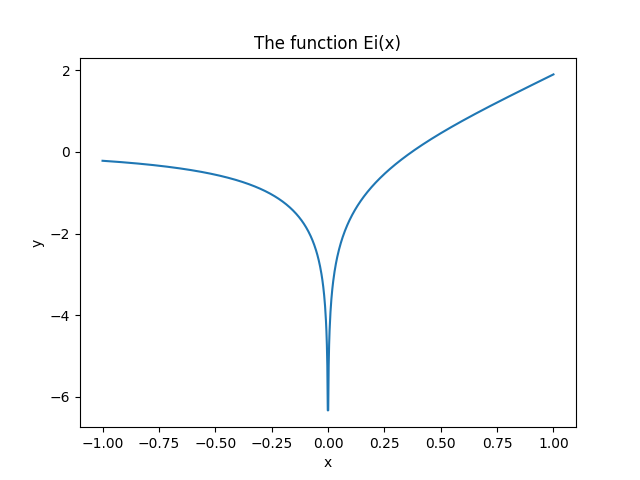 ---
# 3.2. Solving a 2nd order ODE
> Goal : solve and plot the differential equation of a pendulum :
> $$\theta''(t) + b \,\theta'(t) + c \,\sin(\theta(t)) = 0$$
## How to?
Use modules!
- `scipy.integrate.odeint` function for ODE integration
- `matplotlib.pyplot.plot` for 2D plotting
---
```python
import numpy as np
import matplotlib.pyplot as plt
from scipy.integrate import odeint # use Runge-Kutta 4
def pend(y, t, b, c): # function definition
return np.array([y[1], -b*y[1] - c*np.sin(y[0])])
b, c = 0.25, 5.0 # tuple assignment
y0 = np.array([np.pi - 0.1, 0.0])
t = np.linspace(0, 10, 101) # on [0,10] with 101 points
sol = odeint(pend, y0, t, args=(b, c))
plt.plot(t, sol[:, 0], 'b', label=r'$\theta(t)$')# blue
plt.plot(t, sol[:, 1], 'g', label=r'$\omega(t)$')# green
plt.legend(loc='best')
plt.xlabel('t')
plt.grid()
plt.savefig("figures/Pendulum_solution.png")
plt.show()
```
---
---
# 3.2. Solving a 2nd order ODE
> Goal : solve and plot the differential equation of a pendulum :
> $$\theta''(t) + b \,\theta'(t) + c \,\sin(\theta(t)) = 0$$
## How to?
Use modules!
- `scipy.integrate.odeint` function for ODE integration
- `matplotlib.pyplot.plot` for 2D plotting
---
```python
import numpy as np
import matplotlib.pyplot as plt
from scipy.integrate import odeint # use Runge-Kutta 4
def pend(y, t, b, c): # function definition
return np.array([y[1], -b*y[1] - c*np.sin(y[0])])
b, c = 0.25, 5.0 # tuple assignment
y0 = np.array([np.pi - 0.1, 0.0])
t = np.linspace(0, 10, 101) # on [0,10] with 101 points
sol = odeint(pend, y0, t, args=(b, c))
plt.plot(t, sol[:, 0], 'b', label=r'$\theta(t)$')# blue
plt.plot(t, sol[:, 1], 'g', label=r'$\omega(t)$')# green
plt.legend(loc='best')
plt.xlabel('t')
plt.grid()
plt.savefig("figures/Pendulum_solution.png")
plt.show()
```
---
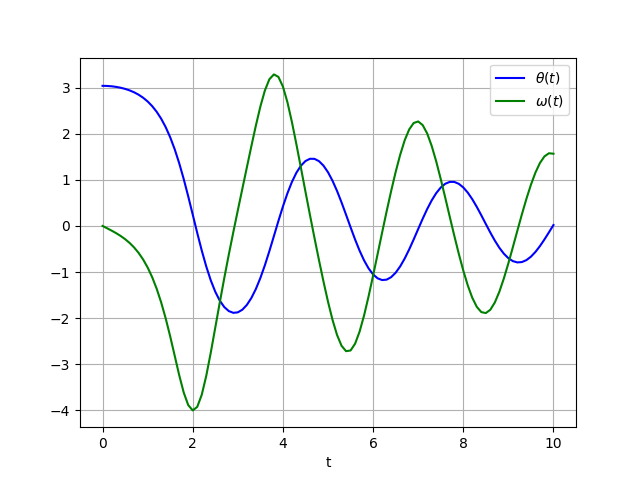 ---
# 3.3. Constraint optimization problem
> Goal: minimize a function under inequality constraints
> $$f(x,y) := (x - 1)^2 + (y - 2.5)^2$$
> $$\text{such that } \begin{cases}x \geq 0 \text{ and } y \geq 0 \\ x - 2y + 2 \geq 0 \\ - x - 2y + 6 \geq 0 \\ x + 2y + 2 \geq 0\end{cases}$$
## How to?
- `scipy.optimize.minimize` function for minimization
- `matplotlib.pyplot.plot` for 2D plotting
---
```python
import numpy as np
import matplotlib.pyplot as plt
from scipy.optimize import minimize
def obj(x): return (x[0] - 1)**2 + (x[1] - 2.5)**2
x0 = (2, 0) # first guess
bnds = ((0, None), (0, None)) # [0, +oo) for x and y
cons = ({'type': 'ineq', 'fun': lambda x: x[0]-2*x[1]+2},
{'type': 'ineq', 'fun': lambda x:-x[0]-2*x[1]+6},
{'type': 'ineq', 'fun': lambda x:-x[0]+2*x[1]+2})
res = minimize(obj, x0, method='SLSQP', bounds=bnds,
constraints=cons)
print("Minimum is", res.x) # (1.4, 1.7)
```
---
# 3.4. A simple neural network
> Using keras (keras.io) it's very simple and concise :sunglasses: !
```python
from keras.models import Sequential
model = Sequential()
from keras.layers import Dense
model.add(Dense(units=64, activation='relu', input_dim=100))
model.add(Dense(units=10, activation='softmax'))
model.compile(loss='categorical_crossentropy',
optimizer='sgd', metrics=['accuracy'])
# x_train and y_train are Numpy arrays
# just like in the Scikit-Learn API.
model.fit(x_train, y_train, epochs=5, batch_size=32)
# evaluate or predict using the model
loss_and_metrics = model.evaluate(x_test, y_test, batch_size=128)
classes = model.predict(x_test, batch_size=128)
```
---
# 3.5. Symbolic computations
- MATLAB has the [Symbolic Math Toolbox](https://www.mathworks.com/pricing-licensing.html?prodcode=SM) (for $400$€/year)…
- Python has the **SymPy** module (sympy.org)
- Ex: Powerful webapp : [sympygamma.com](http://www.sympygamma.com/) (like Wolfram|Alpha)
- :sparkles: Lots of Python code written for numerical values can work directly for symbolic values!
##### a. A few basic examples
##### b. A second example from my latest research article…
+ the same code works for numbers, or exact fractions
+ or symbols $\mu_1,\ldots,\mu_K$ !
---
### Example : generated graph with numbers
---
# 3.3. Constraint optimization problem
> Goal: minimize a function under inequality constraints
> $$f(x,y) := (x - 1)^2 + (y - 2.5)^2$$
> $$\text{such that } \begin{cases}x \geq 0 \text{ and } y \geq 0 \\ x - 2y + 2 \geq 0 \\ - x - 2y + 6 \geq 0 \\ x + 2y + 2 \geq 0\end{cases}$$
## How to?
- `scipy.optimize.minimize` function for minimization
- `matplotlib.pyplot.plot` for 2D plotting
---
```python
import numpy as np
import matplotlib.pyplot as plt
from scipy.optimize import minimize
def obj(x): return (x[0] - 1)**2 + (x[1] - 2.5)**2
x0 = (2, 0) # first guess
bnds = ((0, None), (0, None)) # [0, +oo) for x and y
cons = ({'type': 'ineq', 'fun': lambda x: x[0]-2*x[1]+2},
{'type': 'ineq', 'fun': lambda x:-x[0]-2*x[1]+6},
{'type': 'ineq', 'fun': lambda x:-x[0]+2*x[1]+2})
res = minimize(obj, x0, method='SLSQP', bounds=bnds,
constraints=cons)
print("Minimum is", res.x) # (1.4, 1.7)
```
---
# 3.4. A simple neural network
> Using keras (keras.io) it's very simple and concise :sunglasses: !
```python
from keras.models import Sequential
model = Sequential()
from keras.layers import Dense
model.add(Dense(units=64, activation='relu', input_dim=100))
model.add(Dense(units=10, activation='softmax'))
model.compile(loss='categorical_crossentropy',
optimizer='sgd', metrics=['accuracy'])
# x_train and y_train are Numpy arrays
# just like in the Scikit-Learn API.
model.fit(x_train, y_train, epochs=5, batch_size=32)
# evaluate or predict using the model
loss_and_metrics = model.evaluate(x_test, y_test, batch_size=128)
classes = model.predict(x_test, batch_size=128)
```
---
# 3.5. Symbolic computations
- MATLAB has the [Symbolic Math Toolbox](https://www.mathworks.com/pricing-licensing.html?prodcode=SM) (for $400$€/year)…
- Python has the **SymPy** module (sympy.org)
- Ex: Powerful webapp : [sympygamma.com](http://www.sympygamma.com/) (like Wolfram|Alpha)
- :sparkles: Lots of Python code written for numerical values can work directly for symbolic values!
##### a. A few basic examples
##### b. A second example from my latest research article…
+ the same code works for numbers, or exact fractions
+ or symbols $\mu_1,\ldots,\mu_K$ !
---
### Example : generated graph with numbers
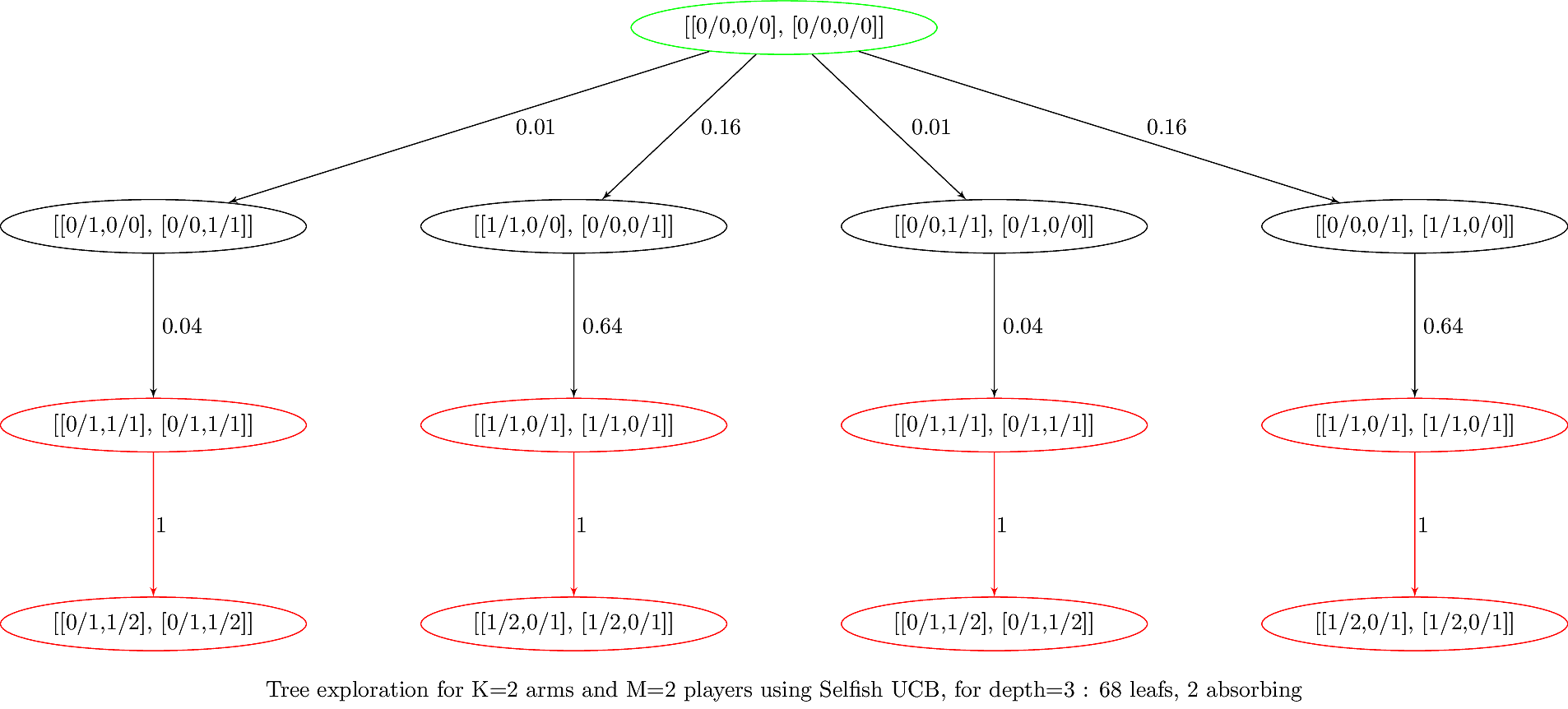 > Graph saved a DOT file and to a TikZ graph with [dot2tex](https://github.com/Naereen/dot2tex)
---
### Example : generated graph with fractions
> Graph saved a DOT file and to a TikZ graph with [dot2tex](https://github.com/Naereen/dot2tex)
---
### Example : generated graph with fractions
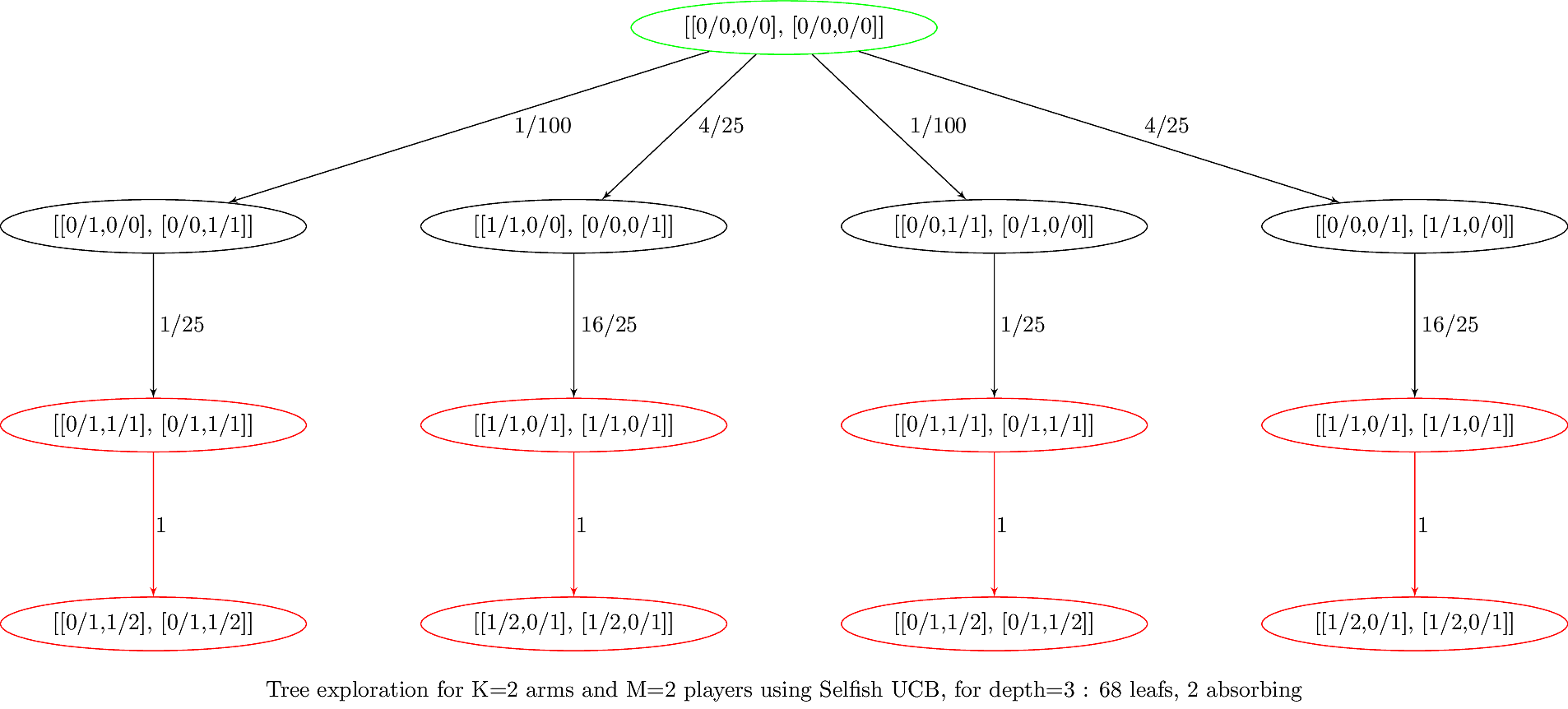 > Source: [banditslilian.gforge.inria.fr/docs/complete_tree_exploration_for_MP_bandits.html](http://banditslilian.gforge.inria.fr/docs/complete_tree_exploration_for_MP_bandits.html)
---
### Example : generated graph with symbols
> Source: [banditslilian.gforge.inria.fr/docs/complete_tree_exploration_for_MP_bandits.html](http://banditslilian.gforge.inria.fr/docs/complete_tree_exploration_for_MP_bandits.html)
---
### Example : generated graph with symbols
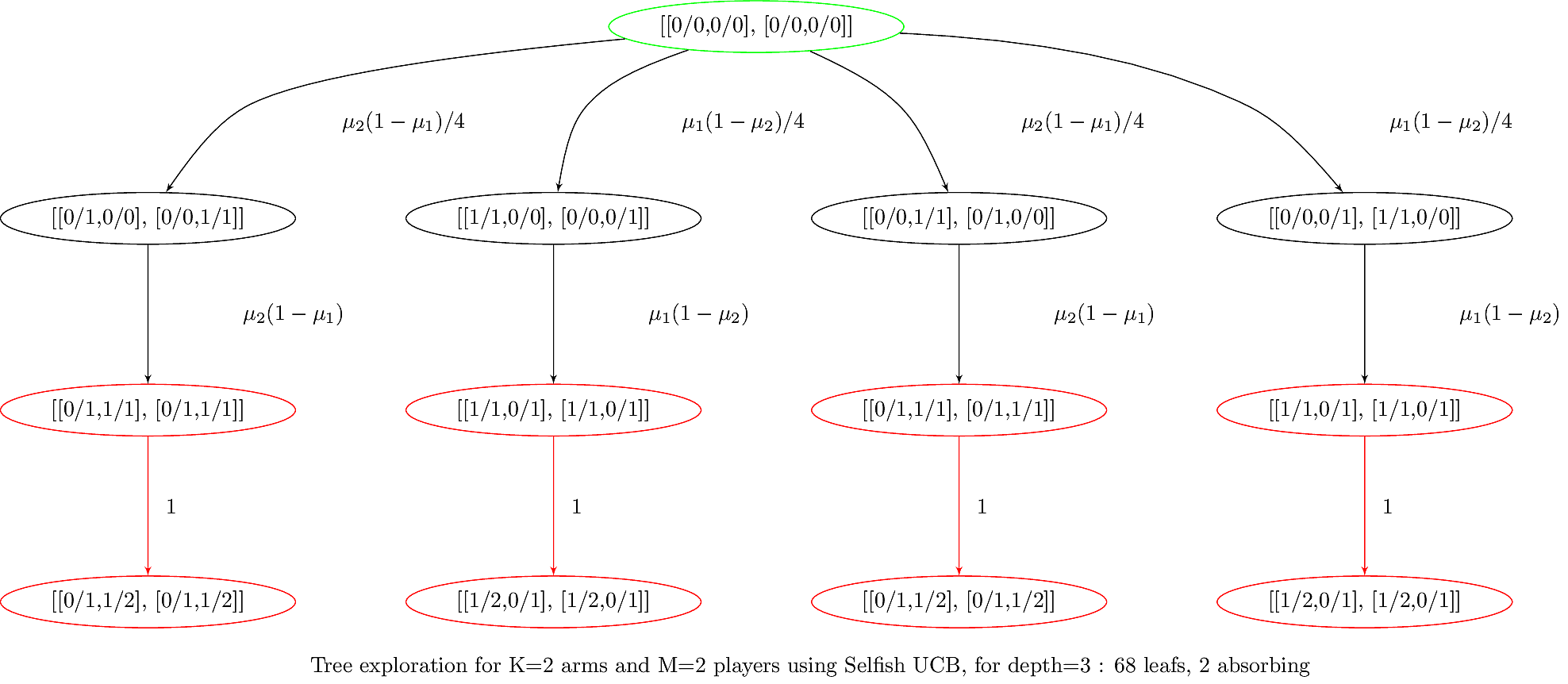 ---
# Conclusion (1/3)
## Sum-up
- I hope you got a good introduction to Python
+ Good tutorials: www.scipy-lectures.org
- It's not hard to migrate from MATLAB to Python
- More ressources:
+ official documentation : docs.scipy.org/doc/numpy-dev/user/numpy-for-matlab-users.html
+ a good 45-minute training video : youtu.be/YkCegjtoHFQ
+ mathesaurus.sourceforge.net/matlab-numpy.html and mathesaurus.sourceforge.net/matlab-python-xref.pdf
---
# Conclusion (2/3)
## Next GouTP @ SCEE
> By Lilian
- Jupyter notebooks for teaching and research
$\hookrightarrow$ jupyter.org
## GouTP @ FAST or AUT ?
> By Pierre Haessig
- Julia programming language (~ between Python and Matlab)
$\hookrightarrow$ julialang.org
> By you ? Any idea is welcome!
---
# Conclusion (3/3)
> *Thanks for joining :clap: !* *Contact us if you want to do a GouTP!*
## Your mission, if you accept it... :boom:
1. *Padawan level:* Train yourself a little bit on Python :snake:
$\hookrightarrow$ introtopython.org or learnpython.org
2. *Jedi level:* Try to solve a numerical system, from your research or teaching, in Python instead of MATLAB
3. *Master level:* From now on, try to use open-source tools for your research (Python and others)
---
# Conclusion (1/3)
## Sum-up
- I hope you got a good introduction to Python
+ Good tutorials: www.scipy-lectures.org
- It's not hard to migrate from MATLAB to Python
- More ressources:
+ official documentation : docs.scipy.org/doc/numpy-dev/user/numpy-for-matlab-users.html
+ a good 45-minute training video : youtu.be/YkCegjtoHFQ
+ mathesaurus.sourceforge.net/matlab-numpy.html and mathesaurus.sourceforge.net/matlab-python-xref.pdf
---
# Conclusion (2/3)
## Next GouTP @ SCEE
> By Lilian
- Jupyter notebooks for teaching and research
$\hookrightarrow$ jupyter.org
## GouTP @ FAST or AUT ?
> By Pierre Haessig
- Julia programming language (~ between Python and Matlab)
$\hookrightarrow$ julialang.org
> By you ? Any idea is welcome!
---
# Conclusion (3/3)
> *Thanks for joining :clap: !* *Contact us if you want to do a GouTP!*
## Your mission, if you accept it... :boom:
1. *Padawan level:* Train yourself a little bit on Python :snake:
$\hookrightarrow$ introtopython.org or learnpython.org
2. *Jedi level:* Try to solve a numerical system, from your research or teaching, in Python instead of MATLAB
3. *Master level:* From now on, try to use open-source tools for your research (Python and others)





